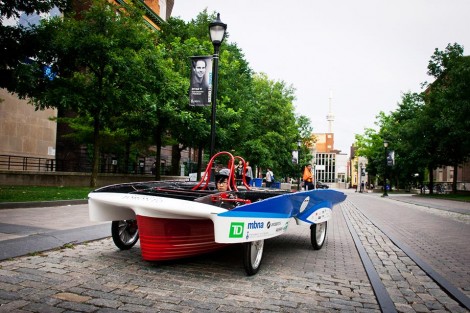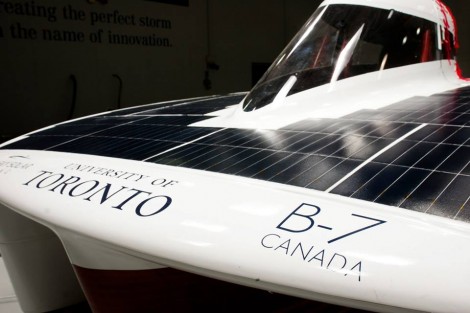The University of Toronto’s Blue Sky Solar Racing team recently unveiled its latest solar car, B-7. The car is set to compete in the 2013 World Solar Challenge, an epic 3000-kilometre race across the Australian outback, from October 6–13.
The Challenge is a biennial competition that was established to promote the development of ultra-efficient cars and sustainable transport. The competition’s 1987 inaugural race attracted 24 contestants representing universities and enterprises from seven different countries At this year’s race, B-7 will be competing against 43 teams from 23 different countries, all with one common goal: to develop an entirely sun-powered car that can make the trek from Darwin to Adelaide in the fastest possible time.
The B-7 will be competing in the prestigious Challenger class, the winner of which receives the World Solar cup. Resembling a spaceship out of Star Wars, the B-7 is 4.49 metres long, 1.79 metres wide, and just 1.35 metres tall. The four-wheel vehicle provides its sole passenger with upright seating and exits on both sides. With six square metres of. solar cells on the roof and a 21-kilogram Lithium-ion battery at the back, the 170-kilogram car can be driven up to a maximum speed of 130 kilometres per hour. The total cost of the car, which is not constrained by competition regulations, is about half a million dollars.
The solar car’s underlying operating principle is simple: photons radiated from the sun carry energy. When the photons hit the solar panels, this energy is captured and converted into electrical energy to drive the motors. At times when the motors do not require power, the captured solar energy is stored in the battery. This stored energy is used during rainy conditions or at night when not enough sunlight is available.
Since the car uses sunlight as its only fuel, the solar array is the car’s most important sub-system. The B-7 uses Sunpower C60 solar cells, one of the most efficient crystalline silicon cells available, which have the ability to use 22.5 per cent of incident sunlight to power the motors. The solar arrays cells have also been cut into smaller segments, enabling the creation of more sub-modules. This leads to a greater amount of captured solar energy. “If you connect the solar cells in series, the cell that receives the least amount of sunlight is the bottleneck. It’s the one [thing] that limits the power of all the other solar cells in series,” explains chief engineer, Ahthavan Sureshkumar. “So by discretizing them into smaller cells, to have more modules, the weakest cell will impede the performance of the entire module less as much.”
Even though cutting the solar cells has increased costs, the team has seen significant improvements in performance.

Jane Liu tests the B-7's mechanical system on the U of T campus. PHOTO COURTESY BLUE SKY SOLAR RACING
The B-7 has been tested at the Bombardier test space and Grand Bend Motorplex. However, the true test will come during the competition, where the car will have to withstand overtaking vehicles, wind gusts, and unexpected weather conditions. Last year, haze created by bush fires, followed by severe rain, led to a disappointing 24th place finish for the U of T-based team. However with a more experienced team and improved designs, the team enters this year’s competition with renewed confidence. Their aim for the 2013 World Solar Challenge: a top-five finish.



